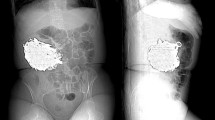Abstract
Purpose
Kaolin eating is an ancestral and worldwide tradition, particularly in women in order to relieve nauseas and abdominal troubles. Nevertheless, damaging effects such as anemia and intestinal troubles are well documented. However, compulsive disorders associated with kaolin intake are less known.
Result
We reported in this paper a severe craving observed in a young woman consuming kaolin for several years, associated with a microcytic iron-deficiency non-regenerative anemia.
Conclusion
This paper allows to draw attention among physicians who are rarely informed of this practice imported from abroad and have consequently a limited role in informing patients of the potential deleterious side effects of geophagia.
Similar content being viewed by others
References
Golden CD, Rasolofoniaina BJ, Benjamin R, Young SL (2012) Pica and amylophagy are common among Malagasy men, women and children. PLoS One 7:1–8. https://doi.org/10.1371/journal.pone.0047129
Coltman CA (1969) Pagophagia and iron lack. JAMA 207:513–516
Young SL (2011) Craving earth: understanding pica-the urge to eat clay, starch, ice, and chalk. Columbia University Press, New-York
Fuortes LJ, Weismann D, Niebyl J, Gergely R, Reynolds S (1996) Pregnancy, pica, pottery, and Pb (lead). J Am Coll Toxicol 15:445–450. https://doi.org/10.3109/10915819609018013
Roy A, Fuentes-Afflick E, Fernald LCH, Young SL (2018) Pica is prevalent and strongly associated with iron deficiency among Hispanic pregnant women living in the United States. Appetite 120:163–170. https://doi.org/10.1016/j.appet.2017.08.033
Miao D, Young SL, Golden CD (2015) A meta-analysis of pica and micronutrient status. Am J Hum Biol 27:84–93. https://doi.org/10.1002/ajhb.22598
Wintrobe MH (2003) Iron deficiency and iron deficiency anemia. In: Wintrobe MM, Greer JP et al (ed) Clinical hematology, 11th edn. Lippincott Williams and Wilkins, Philadelphia
Sontag C, Kettaneh A, Fain O, Eclache V, Thomas M (2001) Rapid regression of prolonged pagophagia after treatment of iron deficiency. Presse Med 30:321–323
Gundacker C, Kutalek R, Glaunach R, Deweis C, Hengstschläger M, Prinz A (2017) Geophagy during pregnancy: Is there a health risk for infants? Environ Res 156:145–147. https://doi.org/10.1016/j.envres.2017.03.028
Lambert V, Boukhari R, Nacher M, Goullé JP, Roudier E, Elguindi W, Laquerrière A, Carles G (2010) Plasma and urinary aluminum concentrations in severely anemic geophagous pregnant women in the Bas Maroni region of French Guiana: a case-control study. Am J Trop Med Hyg 83:1100–1105. https://doi.org/10.4269/ajtmh.2010.10-0370
Funding
The authors did not have any financial support or sponsor for this paper.
Author information
Authors and Affiliations
Corresponding author
Ethics declarations
Conflict of interest
The authors declare that they have no conflict of interest for this paper.
Ethical approval
All procedures performed in studies involving human participants were in accordance with the ethical standards of the institutional and/or national research committee and with the 1964 Helsinki declaration and its later amendments or comparable ethical standards.
Informed consent
Informed consent was obtained from all individual participants included in the study.
Additional information
This article is part of the topical collection on Food and Addiction.
Rights and permissions
About this article
Cite this article
Pain, S., Fauconneau, B., Bouquet, E. et al. Severe craving associated with kaolin consumption. Eat Weight Disord 24, 379–381 (2019). https://doi.org/10.1007/s40519-018-0583-1
Received:
Accepted:
Published:
Issue Date:
DOI: https://doi.org/10.1007/s40519-018-0583-1




